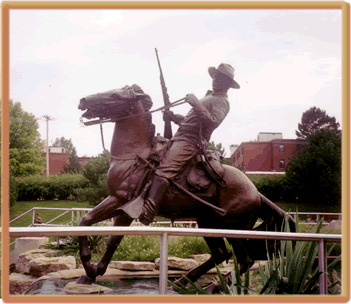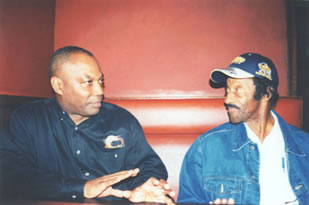Kansas City, Missouri and Ft. Leavenworth, Kansas
George Hicks, III
Carmon Weaver Hicks
February 2005
Kansas City sits on the edge of Kansas and Missouri so both states include
the name. It can be a little confusing when determining if you are in Kansas
City, Kansas or Kansas City, Missouri. It is known as the city of fountains
with 29 fountains spread around the city. Several fountains commemorate military
history as well as African American life in the city.
The African American Historic District at 18th and Vine where the American
Jazz Museum is located honors jazz musicians from the 1920s to 1940s such
as Ella Fitzgerald, Duke Ellington, Louis Armstrong, and Charlie Parker.
The Charlie “Bird” Parker Memorial is a 17-foot bronze statue
located on a plot of land that “Bird” traveled almost daily while
growing up in the city. The Negro League Baseball Museum honors the Kansas
City Monarchs where the Negro League was formed in 1920 and where Jackie
Robinson began his baseball career. Jackie was inducted into the U.S. Army
in 1942 at Fort Riley, Kansas and was assigned to the 9th (Horse) Cavalry
Regiment. At Ft. Riley, he became friends with Joe Louis who was heavy weight
champion of the world and assigned to special services. In 1944, the U.S.
Army gave him an honorable discharge. Jackie played for the Kansas City Monarchs
and became the first African American to play major league baseball with
the Brooklyn Dodgers.
The Harry S. Truman Library and Museum located nearby
in Independence, Missouri offers information about the ending of World War
II, the dropping of the
atomic bomb and the formation of NATO. It is about 30 miles from Kansas City
Fort Leavenworth is the oldest active Army post west of the Mississippi River
and during the country’s westward expansion, was a destination for
thousands of soldiers, surveyors, emigrants, American Indians, preachers,
and settlers. It was established in 1827 and the 10th U.S. Cavalry was established
there in 1866 (http://leav-www.army.mil/cac/history, 6/28/04). It is located
about 30 miles from Kansas City.
In July 2000, George and I went to the 134th Anniversary Reunion of the 9th and 10th (Horse) Cavalry Association in Kansas City. Buffalo Soldiers from the 9th and 10th and the 24th, 25th, 27th, and 28th U.S. Horse Cavalries as well as veterans from the Korean and Viet Nam Wars were active participants. One important event scheduled during the reunion was a bus trip to Fort Leavenworth, Kansas.
Busloads of veterans and their guests traveled to Fort Leavenworth with great anticipation. Conversations were loud and lively as we listened to the veterans tell their stories as well as educators describe how they keep these stories alive. Here is the story about how the Buffalo Soldier Monument was established.
In
1982, when General Colin Powell was Deputy Commander at Fort Leavenworth,
Kansas, he was appalled by the meager recognition of the Buffalo Soldiers.
Two alleys were named in honor of the 9th and 10th U.S. (Horse) Cavalry.
He
vowed that if he was ever in a position to do something to give the Buffalo
Soldiers their due honor, he would. The Buffalo Soldiers Monument was officially
dedicated on July 25, 1992 at Fort Leavenworth. More than 10,000 people were
in attendance when Senator Robert Dole brought the message to approximately
500 veterans from the 9th and 10th (Horse) Cavalry Association. General Colin
Powell was the keynote speaker and Commander Carlton Philpot (Ret.), U.S.
Navy and Chairman of the Buffalo Soldiers Monument Committee received the
Legion
of Merit Medal for making the monument a reality.
Powell stated that the Buffalo Soldiers paved the way for people like him
to obtain their current positions. Without their accomplishments, he would
not
be standing before the crowd. The Buffalo Soldier Monument depicts a young
Buffalo Soldier on horseback scouting in advance of his unit. There is a
reflection pool around the statue with a waterfall in front of the horse.
At certain points
on the walkway around it, the history of the 9th and 10th Cavalry Regiments
with the names of black troopers who were awarded the Congressional Medal
of Honor and their regiments are posted. This site chosen for the monument
was
a fitting location when the 10th was activated at Fort Leavenworth. The troopers
were assigned to camp in the same area where the monument is now. It was
in the most remote part of the post with wet conditions, which aided the
spread
of insects carrying malaria.

Buffalo Soldiers Monument, 2000
Ft. Leavenworth, Kansas
BSRM Collection
Eddie Dixon an African American artist won the commission to render the sculpture for the monument. The message of his Buffalo Soldier is all in the eyes-everything he yearns to say about pain, fear and mistreatment about being rendered invisible by history, about pride and persistence. “When we were growing up, we didn’t have nationally recognized role models; we didn’t know we had heroes. The only two mentioned in the history books were George Washington Carver and Booker T. Washington.”
Dixon
has received numerous national awards. In 1994, the National Association
of Military Museums named him the National Military Artist of the Year.
That same year the National Association of Entrepreneurs honored him. He
has sculptures
in the Air and Space Museum and the National History Museum of the Smithsonian
Institution, the Department of the Interior, the Pentagon, and numerous
national museums, shrines and historical areas. He also has works in corporate
collections
such as Coca Cola and the Annenberg Foundation. Upon graduation from high
school, he served in Vietnam with the 101st Airborne Division from 1968
to 1970. Dixon received his undergraduate degree in chemistry and zoology
and
a master degree in entomology from Texas Tech. (Maraniss, D. September
8, 1991. Washington Post.)
We also visited the Frontier Army Museum located on the grounds of Ft.
Leavenworth. This museum began in 1939 and preserves some of the finest
collections of 19th
century military artifacts. Over 5,000 items such as equipment, uniforms,
and vehicles used by frontier army soldiers are housed there. The museum
is free
and open to the public.
We returned to Kansas City in October 2004 and our visit focused on Trooper James G. Madison. (See His Story section at www.buffalosoldiersresearchmuseum.org ) From our hotel at the downtown Crown Center, we walked to Gates Bar-B-Q Restaurant to meet Trooper Madison. We noticed the Liberty Memorial Museum on a hill across from the Crown Center and Union Station. It is the only public museum in the United States dedicated solely to the history of World War I. Since 1926, this national memorial has honored those who served in World War I; it holds one of the most comprehensive collections of World War I artifacts, relics, and historical materials in the United States.

George Hicks, III and Trooper James Madison
10th Cavalry Buffalo Soldier
Our dinner with Trooper James Madison was delicious and the conversation was informative. Madison is 82 years old and serves as the one and only president of the Kansas City Chapter of the 9th and 10th Horse Cavalry Association. He told us stories about World War II and remembered many specific events. He also talked about his life after the Army which included an invitation from former President Bill Clinton to go to the White House in 1993 for the unveiling of the Buffalo Soldier postage stamp. Madison continues to education youth about his story and the lives of other Buffalo Soldiers. As we left the restaurant, we watched him ride away in his van with a Buffalo Soldier design and logo on the side. He was preparing for his Saturday morning lecture with several other members from his chapter. This Buffalo Soldier’s mission is clear as he continues to keep his story alive.
Kansas City provides an important historical Mecca of information about
the military and the jazz movement for African Americans. It is worth the
trip!
